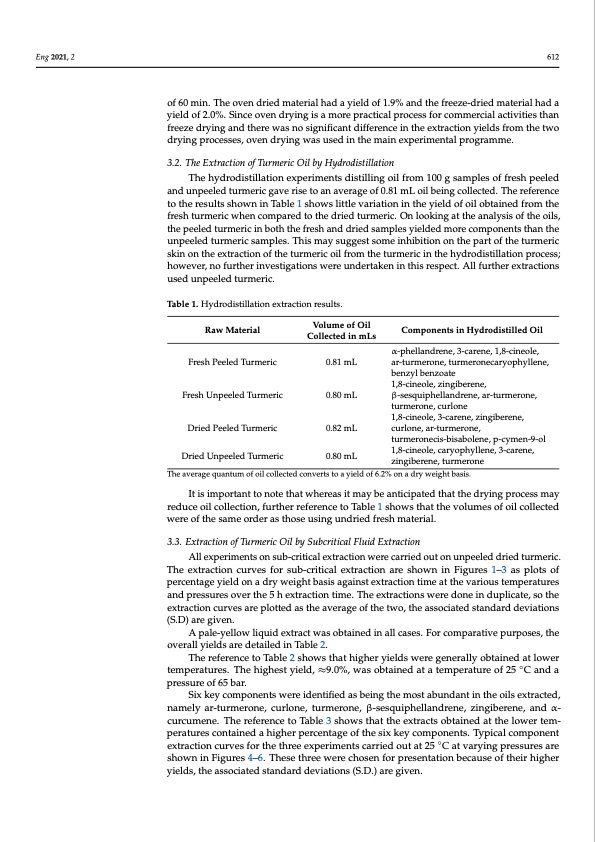
PDF Publication Title:
Text from PDF Page: 005
Eng 2021, 2 612 of 60 min. The oven dried material had a yield of 1.9% and the freeze-dried material had a yield of 2.0%. Since oven drying is a more practical process for commercial activities than freeze drying and there was no significant difference in the extraction yields from the two drying processes, oven drying was used in the main experimental programme. 3.2. The Extraction of Turmeric Oil by Hydrodistillation The hydrodistillation experiments distilling oil from 100 g samples of fresh peeled and unpeeled turmeric gave rise to an average of 0.81 mL oil being collected. The reference to the results shown in Table 1 shows little variation in the yield of oil obtained from the fresh turmeric when compared to the dried turmeric. On looking at the analysis of the oils, the peeled turmeric in both the fresh and dried samples yielded more components than the unpeeled turmeric samples. This may suggest some inhibition on the part of the turmeric skin on the extraction of the turmeric oil from the turmeric in the hydrodistillation process; however, no further investigations were undertaken in this respect. All further extractions used unpeeled turmeric. Table 1. Hydrodistillation extraction results. Raw Material Fresh Peeled Turmeric Fresh Unpeeled Turmeric Dried Peeled Turmeric Volume of Oil Collected in mLs 0.81 mL 0.80 mL 0.82 mL Components in Hydrodistilled Oil α-phellandrene, 3-carene, 1,8-cineole, ar-turmerone, turmeronecaryophyllene, benzyl benzoate 1,8-cineole, zingiberene, β-sesquiphellandrene, ar-turmerone, turmerone, curlone 1,8-cineole, 3-carene, zingiberene, curlone, ar-turmerone, turmeronecis-bisabolene, p-cymen-9-ol 1,8-cineole, caryophyllene, 3-carene, zingiberene, turmerone Dried Unpeeled Turmeric The average quantum of oil collected converts to a yield of 6.2% on a dry weight basis. 0.80 mL It is important to note that whereas it may be anticipated that the drying process may reduce oil collection, further reference to Table 1 shows that the volumes of oil collected were of the same order as those using undried fresh material. 3.3. Extraction of Turmeric Oil by Subcritical Fluid Extraction All experiments on sub-critical extraction were carried out on unpeeled dried turmeric. The extraction curves for sub-critical extraction are shown in Figures 1–3 as plots of percentage yield on a dry weight basis against extraction time at the various temperatures and pressures over the 5 h extraction time. The extractions were done in duplicate, so the extraction curves are plotted as the average of the two, the associated standard deviations (S.D) are given. A pale-yellow liquid extract was obtained in all cases. For comparative purposes, the overall yields are detailed in Table 2. The reference to Table 2 shows that higher yields were generally obtained at lower temperatures. The highest yield, ≈9.0%, was obtained at a temperature of 25 ◦C and a pressure of 65 bar. Six key components were identified as being the most abundant in the oils extracted, namely ar-turmerone, curlone, turmerone, β-sesquiphellandrene, zingiberene, and α- curcumene. The reference to Table 3 shows that the extracts obtained at the lower tem- peratures contained a higher percentage of the six key components. Typical component extraction curves for the three experiments carried out at 25 ◦C at varying pressures are shown in Figures 4–6. These three were chosen for presentation because of their higher yields, the associated standard deviations (S.D.) are given.PDF Image | Sub-Critical Fluid Extraction Turmeric vs Hydrodistillation

PDF Search Title:
Sub-Critical Fluid Extraction Turmeric vs HydrodistillationOriginal File Name Searched:
eng-02-00038.pdfDIY PDF Search: Google It | Yahoo | Bing
CO2 Organic Rankine Cycle Experimenter Platform The supercritical CO2 phase change system is both a heat pump and organic rankine cycle which can be used for those purposes and as a supercritical extractor for advanced subcritical and supercritical extraction technology. Uses include producing nanoparticles, precious metal CO2 extraction, lithium battery recycling, and other applications... More Info
Heat Pumps CO2 ORC Heat Pump System Platform More Info
| CONTACT TEL: 608-238-6001 Email: greg@infinityturbine.com | RSS | AMP |